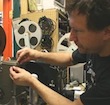|
Author
|
Topic: 16mm prints restoration
|
Gian Luca Mario Loncrini
Phenomenal Film Handler

Posts: 1948
From: Verona (Italy)
Registered: Jan 2009
|
 posted October 29, 2009 07:09 PM
posted October 29, 2009 07:09 PM





You absolutely have to see what this BRILLANT GENIOUS has invented. A genuine way to restaure 16mm prints, by adding, for example, missing parts or segments to an old copy.
Just a little hard, maybe, to understand all steps written in Italian. But all images will help you.
Believe me: this is a real talented collector.
I had to post immediately the video he uploaded on YouTube as soon as I've seen it first to show you his tecnique (of course he knows I did). Simply incredible.
Some Italian collectors have already contacted him to ask for missing opening credits or missing sequences. So incredible the way he works. So stunning the result. And, wow, he could even print brand new copies, considering he acquires the footage from DVDs. Well, I don't know about costs... ![[Roll Eyes]](rolleyes.gif)
You probably know I don't collect 16mm (and here in Italy a lot of 'us' already asked him if it is possible to do the same with 8mm prints. The answer was negative because of a lot of reasons you can imagine. Magnetic sound, just to make an example, or difficult in finding 8mm stock).
But LOOK AT THIS and you won't believe your eyes:
16mm prints restoration on YouTube
--------------------
I remember when I was (super) 8 years old...
| IP: Logged
|
|
|
|
|
|
|
|
|
|
|
|
|
|
|
|
|
|
|
|
|
|
Martin Jones
Phenomenal Film Handler
Posts: 1269
From: Thetford , Norfolk,England
Registered: May 2008
|
 posted October 31, 2009 02:18 PM
posted October 31, 2009 02:18 PM



I don't speak or read Italian so I can only go by the visuals; I may have missed some of the salient points.
Steve has it right, "Kinescoping" in the States and "Telerecording" in the UK before magnetic video recording was invented. Difficult to do "on the fly" because it has to be done at the same speed as the TV material, 25 fps instead of 24 fps to avoid flicker, which creates a non standard projection speed.
However, it can also be done by using Animation techniques; the DVD is advanced one frame at a time and the camera takes single frames to match. Every 24 frames, the 25th is ignored. This results in a silent copy of the film running at normal sound speed , but 4% shorter than the original in running time. The sound track is lifted from the DVD and shortened by the same amount, using a computer to keep the pitch correct, and then re-married to the visuals either optically or magnetically. Material transferred this way can be inter-cut with original material; people move and talk slightly faster, but not obviously so, as the sound pitch is correct.
Martin
--------------------
Retired TV Service Engineer
Ongoing interest in Telecine....
| IP: Logged
|
|
|
|
|
|
|
|
|
|
|
|
|
|
|
|
|
|
|
|
|
|
|
|
|
|
|
|



 UBBFriend: Email this page to someone!
UBBFriend: Email this page to someone!
 Printer-friendly view of this topic
Printer-friendly view of this topic






![[Roll Eyes]](rolleyes.gif)


![[Big Grin]](biggrin.gif) )
)![[Wink]](wink.gif)



